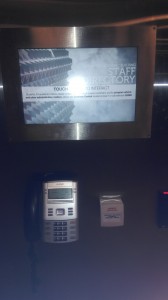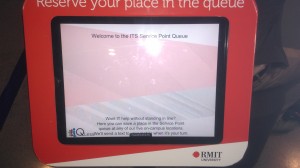Media 1, Lectorial 2, What is Media?
Media is not a ‘thing’ out there
‘The media are not so much ‘things’ as places which most of us inhabit, which weave in and out of our lives. Their constant message and pleasures seem to flow around and through us, and they immerse most of our waking lives’.
In this post-broadcast age, as individuals we are defined by what media we consume and interact with. Artistically and practically media is a big part of not only our environment but who we are. Through media I can share and listen to my favourite music and films, I can text, call and message friends, I can find out world news, book holidays, buy clothes……….all this is all at the touch of a button.
Even when interacting with the outside world, media is everywhere, places are constructed and in turn defined by it. In the Lectorial Exercise-‘Media is everywhere’ my group spent 45 minutes to an hour in the RMIT building noticing media. Some things we found are: Virtual Cue Checker, Interactive Service, Feedback Machine, toilet sign, projector of rmit info, information sign, rooftop design, advertising/print, vending machine, ipads on stands, elevator noises, radio, music, Pokémon posters……..
These are all things that we experience, but don’t notice every day. This activity is correlated to John Cages, four minutes and 33 seconds which forces the audience to have heightened awareness of their surroundings. Generally when listening to music, an individual isn’t thinking about the chair they are sitting on or what’s going on behind them, however when Cage did this live (and no sound occurred) people began reacting too and noticing their environment. In our exercise today a similar thing occurred due to our heightened awareness and focus on what we were supposed to be doing (noticing). This was certainly an eye opening experience.
Something, I found particularly interesting in John Masons ‘the disciplines of noticing’ was account 7 ‘Natasha’. In everyday life, when a child does this, you presume they are being demanding and dismiss what they are doing entirely. However the narrator draws significant meaning from the everyday scenario ‘the remembrance was of the feelings which welled up in me’. This demonstrates that making a conscious effort when looking at the ordinary can not only be thought provoking, but can explain/justify certain behaviours and behavioural patterns.
What do you think of when you think of Media?
- Film
- Advertising and the various media involved with it.
- Radio
- Writing
- Rupert Murdoch
What others said
Dissemination, globalisation, art, publicity, propaganda, books and paper, technology, journalism.
Interesting Thought
The media can also confine us, pigeon hole us, targeted advertising, in a way it is paradoxical. Due to the now streamline nature of media; we are forced to create a self-image based on how we interact with it. For example, if we wish to share music on Facebook or Spotify, people make judgments on us based on what we share. If our timeline photo on Facebook is the colour green, individuals won’t see the individual as playful as someone who has the colour Pink. Though post-modern media grants us freedom, it can also confine us. An example given in the lecture was with iPhone cases, when we go to the store we have quite few options to pick from, lets say 30, we still end up picking an option that we believe says something about ourselves, that corresponds to our tastes and who we are. Currently, media does a simular thing, when we consume we choose to represent ourselves with that product, in turn pigeon holing ourselves
Notes taken from the Lectorial on, ‘Media ‘texts’
– Sites where meanings are generated through the manipulation of materials and codes.
– Do not simply ‘picture’ or ‘reflect’ a reality where meaning resides.
– Dorothy Smith- argues for considering ‘textually mediated communication, action, and social relations’ as integral parts of our social environment.
– We generate some perception through media, for example our idea of London, I have images and places in my head, but I’ve never been there.
– Premodern society: Social world predominately through, face to face interactions and direct experience.
– Modern society: Predominantly through media/texts. Maps, books, newspapers.-Globalization and rapidisation of media text have made the world easily accessible, people are connected through media.
– We are moving away from an old model of media and communication, it is no longer purely sender-medium-message- receiver. It is a stream of reciprocal creativity and interaction where the consumer (now the prosumer) can interact with and respond too various texts. Media no longer has a linear, one directional flow.
Lectorial Audit
– Screens everywhere
– graffiti
– phone/facebook
– posters
-traffic lights
– buskers
– business cards
– Googling
MERRINS ARTICLE
William Merrins article ‘studying me-dia: The problem of method in a post-broadcast age’ highlights the shift from a Broadcast to Post-Broadcast world. In our current post broadcast world, the consumer has too much say, we create, dictate and manipulate media in order to suit our identity. We no longer accept what is offered for the majority, however we instead mould what we want to consume based off our own hobbies and interests. Due to the individualisation of ME-dia, the ability to gain to gain empirical data is effectively rendered useless.
Questions asked spawning from Merrins article
– William Merrin, ‘studying media: the problem of method in a Post-Broadcast age’. There are more producers and smaller, niche audiences. In this Merrin piece he states that the individual has all the choice, control and freedom.
How do we use Media to produce our identity? How do we use it to change the world?
The media can also confine us, pigeon hole us, targeted advertising, in a way it is paradoxical.
– Think about Media as a place, as something that helps work out particular social relations.
Example: Shibuya, Media bombards you. How does Media give identities to places?
How can new media shift/mould social identities, how does this new technology effect the culture?
Media can normalise particular activities, for example ‘Punk Music’ the press can contain it, demonise it or make it appear harmless.The ‘Image’ of punk is controlled by media. If it wast for the media, we may see Punk as organic.


